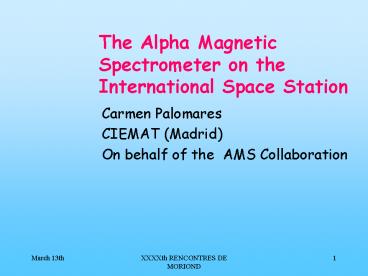The Alpha Magnetic Spectrometer on the International Space Station - PowerPoint PPT Presentation
Title:
The Alpha Magnetic Spectrometer on the International Space Station
Description:
March 13th. XXXXth RENCONTRES DE MORIOND. 1 ... March 13th. XXXXth RENCONTRES DE MORIOND. 3. AMS-02. Large geometrical acceptance: 0.45 m2 sr ... – PowerPoint PPT presentation
Number of Views:80
Avg rating:3.0/5.0
Title: The Alpha Magnetic Spectrometer on the International Space Station
1
The Alpha Magnetic Spectrometer on the
International Space Station
- Carmen Palomares
- CIEMAT (Madrid)
- On behalf of the AMS Collaboration
2
AMS is a magnetic spectrometer to be installed on
ISS (? 450 km) The aim of AMS is the direct
detection of primary cosmic rays below the knee
(NO UHECR) Determination of energy with high
resolution Large statistics Very good particle
identification
3
AMS-02
- Large geometrical acceptance 0.45 m2 sr
- Long exposure 3 years
- Redundant measurements of the main
- parameters
- Operational conditions
- High vacuum
- High radiation levels
- Strong gradients of temperature
- -60C 40C
- Weight lt 7 Tons
- Acceleration 3g (6g) launch (landing)
- Power consumption lt 3 kW
4
AMS Goals
Antimatter search ( ) with a sensitivity 103
better than current limits
Dark matter search. Non-baryonic DM WIMP
(LSP) Signatures e,
- High statistics study of
- the cosmic ray spectrum
- Isotope separation
- Antiparticle spectrum
5
AMS detector
Set of sub detectors devoted to the measurement
of energy and particle identification Z, mass,
6
AMS detector
Energy ( , )
Tracker
?(R)/R 1.5 for 10 GV Max. Dynamic Range 1 TV
ECAL
?(E)/E 3 for 100 GeV electrons
7
AMS detector
Particle Identification
Charge (Z) Tracker, ToF and RICH Z ? 26 (small
charge confusion) Tracker ToF ? sing(Z)
- Electron/hadron separation
- TRD p/e rejection factor 102 - 103
- in the range 1.5 300 GeV
- ECAL Hadron rejection factor 104
- for Elt1TeV
Test-beam results
- (Mass)
- ToF ?(?)/? 3.5 (for ?1)
- RICH ?(?)/? 0.1 for protons
- ?(m)/m 2
8
AMS detector status
- The sub-detectors have been tested
- Test-beams at CERN using prototypes of the final
detectors - Qualification tests of the flight elements
- Currently, they are being assembled and qualified
- Integration and functional tests of the whole
detector at CERN (2006)
Magnet coils already done
ToF
9
Galactic Cosmic Rays
The high energy CR are produced, accelerated and
propagated in the Galaxy and provide information
about the sources and the matter content and
magneto- hydrodynamical properties of our Galaxy
- Current critical measurements that can be
achieved by AMS are - Very accuracy measurements of the spectrum of H
He (R? 1 TV) - Chemical abundances (from H to Fe)
- The ratio of spallation products such as Boron
to the primary nuclei - such as Carbon as a function of energy (E ? 1
TeV) - The energy dependence of the fraction of
antiparticles (E?100GeV) - Isotopic ratios of elements (E ? 10 GV)
10
Energy Spectrum
Protons and Helium The most abundant elements
Spectral index Origin and acceleration,
differences between both species Used to
determine the expected fluxes of and e ,
atmospheric neutrinos, etc
protons
AMS-02 expectations
Helium
AMS-02 expectations
11
Hadrons Zgt2
In addition to the information provided by
primary CR such as C, N and O, secondary CR
(produced by spallation) are used to estimate the
amount of matter traversed by the
CR (confinement volume and time)
AMS-02 expectations
12
Radiactive Isotopes Provide information about
the confinement time of CR in the Galaxy
10Be is specially interesting for its half time
(t1/2 1.51 106 years) of the same order than
the confinement time of the CR in the Galaxy
AMS-02 expectations
- After 3 years, AMS will collect 105 10Be
- ?(m)/m 2
13
Antiparticles
Pure secondary CR from interactions with the ISM
Exotic origin A very good understanding of the
expected CR fluxes
Positrons
Antiprotons
Data consistent with secondary CR
No conclusive data
14
Antiparticles
AMS will measure the flux up to 400
GeV After 3 years will collect ?106
AMS will collect ?106 e and ?107 e- These
fluxes provide sensitivity to darkmatter in
several scenarios
AMS-02 expectations
AMS-02 expectations
15
Summary
- AMS will be the first large acceptance magnetic
spectrometer - to operate in space for a long period of time
- Precise experimental measurements provided by
AMS would - yield information about the galactic
properties, constraining - propagation models
- AMS will be able also to discover some evidence
for new - physics (dark matter) or new objects (e.g.
stars made of - antimatter)
- Currently, AMS-02 is in the construction phase.
- The detector must be ready for the launch by
the end of 2007
16
More Slides
17
Light Isotopes
D and 3He are secondary particles coming from
nuclear interactions with the ISM and provide a
description of the propagation of p and He
AMS-02 expectations
AMS-02 expectations
18
Search of antimatter
19
- Good understanding of GCR origin and propagation
will be used to discover some evidence for new
physics (dark matter) or new objects (e.g. stars
made of antimatter)
20
ECAL
21
Ring Imaging Cerenkov Detector
Radiator (aerogel)
?(?)/? 0.1 para ?1
Charge determination up to Z26
mirror
PMT Plane
22
Transition Radiation Detector
20 layers































